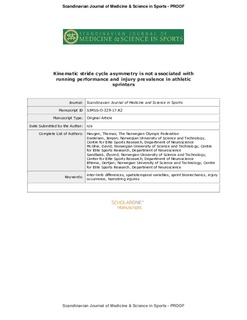| dc.contributor.author | Haugen, Thomas | |
| dc.contributor.author | Danielsen, Jørgen | |
| dc.contributor.author | McGhie, David | |
| dc.contributor.author | Sandbakk, Øyvind | |
| dc.contributor.author | Ettema, Gertjan | |
| dc.date.accessioned | 2018-01-22T14:24:20Z | |
| dc.date.available | 2018-01-22T14:24:20Z | |
| dc.date.created | 2018-01-08T10:08:40Z | |
| dc.date.issued | 2017 | |
| dc.identifier.citation | Scandinavian Journal of Medicine & Science in Sports. 2017, 1-8. | nb_NO |
| dc.identifier.issn | 0905-7188 | |
| dc.identifier.uri | http://hdl.handle.net/11250/2478809 | |
| dc.description.abstract | The aims of this study were to (a) quantify the magnitude of kinematic stride cycle asymmetry in high-level athletic sprinters, (b) explore the association between kinematic asymmetry and maximal sprint running performance, and (c) investigate possible associations between kinematic asymmetry and injury prevalence. Twenty-two competitive sprinters (age 23 ± 3 year, height 1.81 ± 0.06 m, body mass 75.5 ± 5.6 kg, personal best 100 m 10.86 ± 0.22 seconds) performed 2-3 flying sprints over 20 m. Kinematics were recorded in 3D using a motion tracking system with 21 cameras at a 250 Hz sampling rate, allowing assessment of six consecutive steps for each athlete. Information about injuries sustained 1 year prior to and after the experiment was continuously registered (type, location, severity/duration, and time of year occurrence). The results showed that ≥11 of the 22 participating athletes displayed large or very large asymmetry for at least 11 of 14 variables, and all athletes displayed large or very large asymmetry for at least three variables. No correlations between individual magnitudes of asymmetry and sprint performance were significant (trivial to moderate). No significant changes in asymmetry between best and worst trial were observed for any of the analyzed variables. In addition, injured and non-injured athletes did not differ in asymmetry, neither for the time period 1 year prior to nor after the test. In conclusion, kinematic asymmetries in the stride cycle were not associated with neither maximal sprint running performance nor the prevalence of injury among high-level athletic sprinters. | nb_NO |
| dc.language.iso | eng | nb_NO |
| dc.publisher | Wiley | nb_NO |
| dc.title | Kinematic stride cycle asymmetry is not associated with sprint performance and injury prevalence in athletic sprinters | nb_NO |
| dc.type | Journal article | nb_NO |
| dc.type | Peer reviewed | nb_NO |
| dc.description.version | acceptedVersion | nb_NO |
| dc.source.pagenumber | 1-8 | nb_NO |
| dc.source.journal | Scandinavian Journal of Medicine & Science in Sports | nb_NO |
| dc.identifier.doi | 10.1111/sms.12953 | |
| dc.identifier.cristin | 1537384 | |
| dc.description.localcode | This is the peer reviewed version of the following article: [Kinematic stride cycle asymmetry is not associated with sprint performance and injury prevalence in athletic sprinters], which has been published in final form at [http://onlinelibrary.wiley.com/doi/10.1111/sms.12953/abstract]. This article may be used for non-commercial purposes in accordance with Wiley Terms and Conditions for Self-Archiving. Locked until 15.8.2018 due to copyright restrictions. | nb_NO |
| cristin.unitcode | 194,65,30,0 | |
| cristin.unitname | Institutt for nevromedisin og bevegelsesvitenskap | |
| cristin.ispublished | true | |
| cristin.fulltext | postprint | |
| cristin.qualitycode | 2 | |
